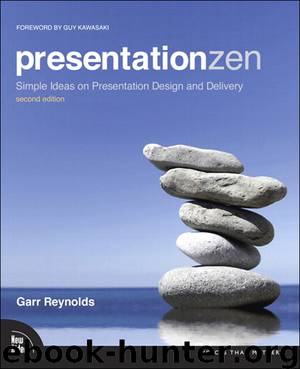Presentation Zen: Simple Ideas on Presentation Design and Delivery, 2nd Edition (Ira Katz's Library) by Garr Reynolds

Author:Garr Reynolds
Language: eng
Format: epub
Publisher: New Riders
Published: 2012-03-24T16:00:00+00:00
Is the Nonessential Always “Noise”?
It is generally true that unnecessary elements decrease a design’s efficiency and increase the possibility of unintended consequences. But does this mean that we must remove everything that is not absolutely essential to a design? Some say a minimalist approach is the most efficient. But efficiency itself is not necessarily an absolute good and not always the ideal approach.
When it comes to the display of quantitative information using charts, tables, graphs, etc., I strongly favor designs that include the highest SNR possible without adornment. I use a lot of photographs in my presentations, so when I do show a chart or a graph, I usually do not place other elements on the slide. There is nothing wrong with placing a bar chart, for example, over a background image (as long as there is proper contrast or salience), but I think the data itself (with a high SNR) can be a very powerful, memorable graphic on its own.
With other visuals, however, you may want to consider including or retaining elements that serve to support the message at a more emotional level. This may seem like a contradiction to the idea that “less is more.” However, emotional elements often do matter—sometimes, they matter a lot. Clarity should be your guiding principle. As with all things, balance is important and the use of emotional elements depends on your particular circumstance, audience, and objectives. In the end, SNR is one principle among many to consider when creating visual messages.
Download
This site does not store any files on its server. We only index and link to content provided by other sites. Please contact the content providers to delete copyright contents if any and email us, we'll remove relevant links or contents immediately.
Deep Learning with Python by François Chollet(14614)
The Mikado Method by Ola Ellnestam Daniel Brolund(11869)
Hello! Python by Anthony Briggs(11789)
OCA Java SE 8 Programmer I Certification Guide by Mala Gupta(11240)
Dependency Injection in .NET by Mark Seemann(11001)
A Developer's Guide to Building Resilient Cloud Applications with Azure by Hamida Rebai Trabelsi(10500)
Algorithms of the Intelligent Web by Haralambos Marmanis;Dmitry Babenko(9832)
The Well-Grounded Java Developer by Benjamin J. Evans Martijn Verburg(9420)
Grails in Action by Glen Smith Peter Ledbrook(9163)
Hit Refresh by Satya Nadella(9038)
Sass and Compass in Action by Wynn Netherland Nathan Weizenbaum Chris Eppstein Brandon Mathis(8808)
Secrets of the JavaScript Ninja by John Resig Bear Bibeault(8594)
The Kubernetes Operator Framework Book by Michael Dame(8453)
Test-Driven iOS Development with Swift 4 by Dominik Hauser(8308)
Exploring Deepfakes by Bryan Lyon and Matt Tora(8268)
Robo-Advisor with Python by Aki Ranin(8228)
Practical Computer Architecture with Python and ARM by Alan Clements(8204)
Implementing Enterprise Observability for Success by Manisha Agrawal and Karun Krishnannair(8176)
Building Low Latency Applications with C++ by Sourav Ghosh(8076)
